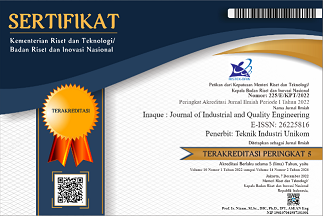PERANCANGAN ALAT PENGUPAS SABUT KELAPA MENGGUNAKAN METODE VDI 2221
DOI:
https://doi.org/10.34010/iqe.v9i2.5147Abstract
The increasing demand for coconut productin in Sungai Kupah Village, Kuburaya Regency has resulted in workers needing a tool that can complete work more quickly and effiently. The tools used today stil use wedges where their use takes a long tie because the process in the process relies on human power. In additin, with non-ergonomic work positins, workers can also experience several work-related diseases such as back pain and back pain. The objecties of this research are (1) Designing an ergonomic coconut peeler according to consumer needs (2) Testig the performance of the tool (3) Testig worker fatiue before and aftr using the tool (4) Testig the level of consumer satifactin. The solutin used in this study is the VDI 2221, CVL method approach, measuring tool performance and analyzing the level of satifactin. The results obtained in this study are (1) produce a tool design according to consumer needs and have paid attntin to ergonomic aspects (2) The design of this tool produces a fairly fast stripping tie of 143 peeling fruit/hour when compared to tools using a wedge, namely 92 peeling fruit/hour (3) Worker fatiue test aftr using this tool showed 14.42 % of coconut owners, 11.20 % of worker 1 and 10.48 % of worker 2. This test resulted in CVL below 30% where workers did not experience fatiue. (4) Respondents feel comfortable with the designed tool as evidenced by the results of the 4.8 Linkert scale. Meanwhile, for ease of operatin, the result is 4.3, which means that respondents fid it easy to operate the designed tool. The conclusion in this study is that the currently designed tools are quite effctie, ergonomic and able to reduce the level of worker fatiue.
Downloads
Published
Issue
Section
License
Authors who publish this journal agree to the following terms:
The author holds the copyright and grants the right of the first publication journal to enable INAQUE to share the work with acknowledgment of the author's work and early publications in this journal.
Authors may include separate additional contractual arrangements for the non-exclusive distribution of the journal's published version (for example, submit to an institutional repository or publish in a book), with the acknowledgment of its initial publication in this journal
Authors are permitted and encouraged to post their work online before and during the delivery process, as it may lead to productive exchanges, as well as quotations of previously published and longer works








